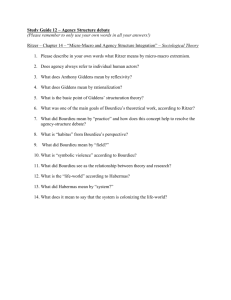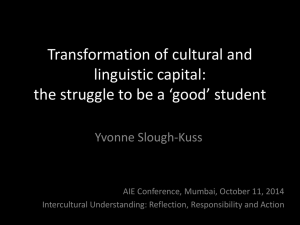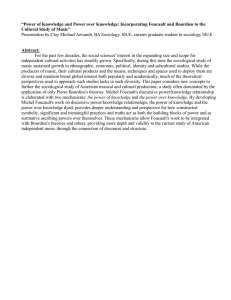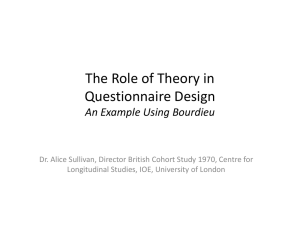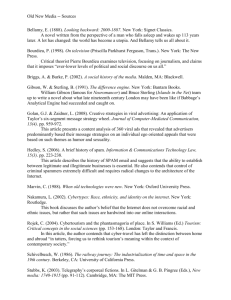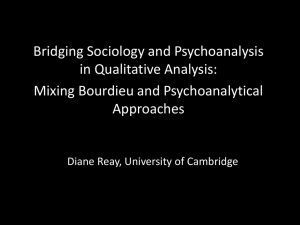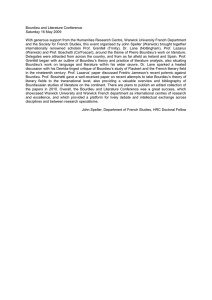Outline and assess Bourdieu`s explanation of social inequality.
advertisement
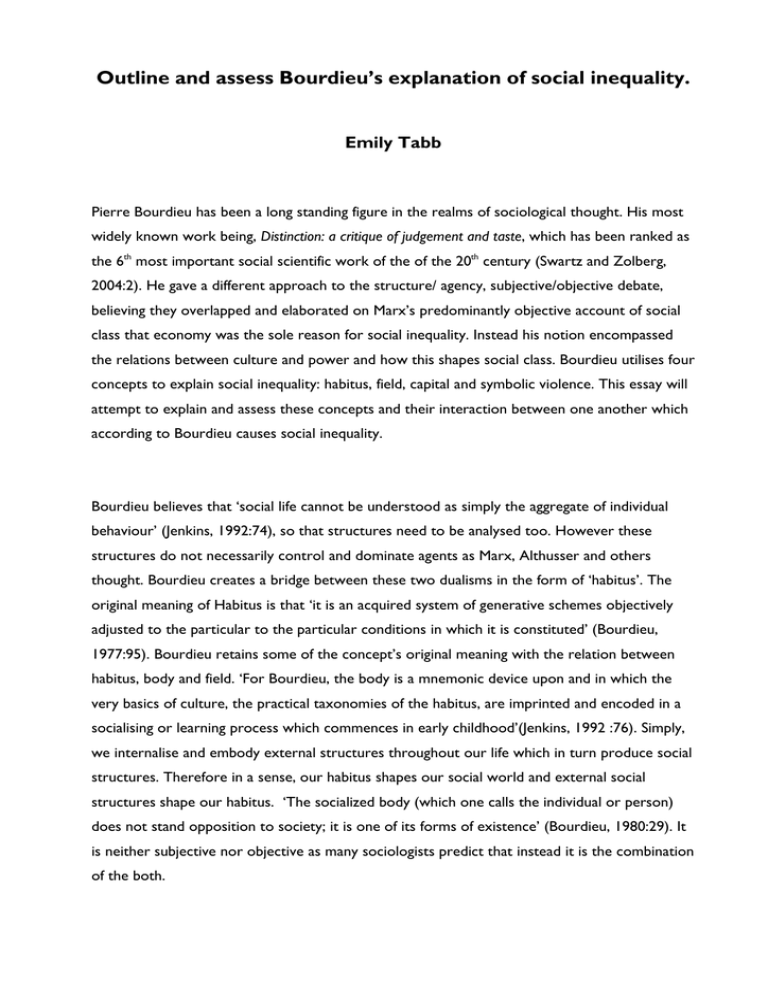
Outline and assess Bourdieu’s explanation of social inequality. Emily Tabb Pierre Bourdieu has been a long standing figure in the realms of sociological thought. His most widely known work being, Distinction: a critique of judgement and taste, which has been ranked as the 6th most important social scientific work of the of the 20th century (Swartz and Zolberg, 2004:2). He gave a different approach to the structure/ agency, subjective/objective debate, believing they overlapped and elaborated on Marx’s predominantly objective account of social class that economy was the sole reason for social inequality. Instead his notion encompassed the relations between culture and power and how this shapes social class. Bourdieu utilises four concepts to explain social inequality: habitus, field, capital and symbolic violence. This essay will attempt to explain and assess these concepts and their interaction between one another which according to Bourdieu causes social inequality. Bourdieu believes that ‘social life cannot be understood as simply the aggregate of individual behaviour’ (Jenkins, 1992:74), so that structures need to be analysed too. However these structures do not necessarily control and dominate agents as Marx, Althusser and others thought. Bourdieu creates a bridge between these two dualisms in the form of ‘habitus’. The original meaning of Habitus is that ‘it is an acquired system of generative schemes objectively adjusted to the particular to the particular conditions in which it is constituted’ (Bourdieu, 1977:95). Bourdieu retains some of the concept’s original meaning with the relation between habitus, body and field. ‘For Bourdieu, the body is a mnemonic device upon and in which the very basics of culture, the practical taxonomies of the habitus, are imprinted and encoded in a socialising or learning process which commences in early childhood’(Jenkins, 1992 :76). Simply, we internalise and embody external structures throughout our life which in turn produce social structures. Therefore in a sense, our habitus shapes our social world and external social structures shape our habitus. ‘The socialized body (which one calls the individual or person) does not stand opposition to society; it is one of its forms of existence’ (Bourdieu, 1980:29). It is neither subjective nor objective as many sociologists predict that instead it is the combination of the both. Another difference to previous theory is that the habitus does not determine action; rather it constrains ‘practice’. However, individuals do make decisions based on principles outside an individual’s control. In Bourdieu’s own words ‘agents classify themselves, expose themselves to classification, by choosing, in conformity with their tastes, different attributes, clothes, types of food, drinks, sports, friends which go well together, and which they find suitable for their position.’ (Bourdieu, 1990:132) Hence, our habitus coincides with our class position. We share a similar habitus to those of a similar social class which our habitus often correlates with our field; and ‘legitmates economic and social inequality by providing a practical and taken for granted acceptance of the fundamental conditions of existence.’ (Swartz, 2004:96) This in turn can lead to symbolic violence. Bourdieu defines a field: as a network, or a configuration, of objective relations between positions objectively defined in their existence and in the determinations they impose upon their occupants, agents or institutions, by their present and potential situation…in the structure of the distribution of power (capital) who possession commands access to the specific profits that are at stake in the field, as well as by their objective relation to other positions (Bourdieu & Wacquant, 1992:39). Consequently his concept of field is there to provide a framework for analysis of the agents and their positions within a given field. The position of the agent is a result of the interaction between the individual’s habitus and his or her place within the position of the field and how much capital that person has accumulated (Caholn, 1992:5). This accumulation of economic and cultural capital decides whether people are subordinate or dominant in the fields. Bourdieu acknowledges that ‘Positions in fields can to some extent be shaped by the habitus that actors bring with them’ (Bourdieu and Boltanskil 1975, cited in Swartz 123). This therefore exposes the belief that Bourdieu does not just believe structures cause social inequality but the agents do too. There are many varieties of fields that exist; all consist of their own internal logic and regulatory principles that govern the agenda of the field. Power of course is the most important field; power being the root of all struggles carried out over symbolic and material resources. This struggle for symbolic resources is central to Bourdieu’s theory. Bourdieu highlights unlike other sociologists that geographic location can play in part in the field of power as one could be nearer to cultural capital than others. ‘Bourdieu compares the structure of a field to that of a poker game where the pile of chips reflects the unequal distribution of capital that both summarizes the results of previous struggles and orient strategies for the future’ (Bourdieu and Wacquant 1992:98-99, cited in Swartz, 1997:123) One can see that a field is a ‘site of struggle’ whereby agents have to compete to gain monopoly amongst these fields; ‘struggles over the power to define each field’ (Calholn, 1992:6). This is different to other sociologists similar concepts: Goffman’s total institutions, Althusser’s ‘ideological state apparatus’ and Foucault’s ‘order of discipline’ are seen as functional rather than sites of struggles. The fundamental difference between Bourdieu’s concept of field and Althusser’s concept of ‘ideological state apparatus’ is that Bourdieu allows for resistance against the dominant power. (Bourdieu and Wacquant, 1992:102) Bourdieu recognises under certain historical situations that a field could begin as an apparatus only if the dominant are able to eliminate successfully any resistance that the subordinate give. As a result of this formation of resistance, Bourdieu thinks that his work is dissimilar to Foucault’s theory of domination because ‘his frameworks allows for resistance whereas that Foucault does not’ (Bourdieu and Waquant, 1992, cited in Swartz, 1997:124). This is naturally a positive as he acknowledges that not everyone automatically accepts everything as it is. There is some resistance to the dominant classes. However it could be argued that there is no indication of this room for resistance in his frameworks as he sees that there is no chance of a ‘deficit habitus’ and the habitus logic governs the classificatory system. ‘This common classificatory logic is always adjusted to the division of the established order (and thereby the interest of those who dominate it)’ (Garnham, cited in Calhol et al, 1993:183). Therefore this logic eradicates any chance of resistance. The fact that Bourdieu’s see culture as arbitrary also affirms this lack of room for resistance. This links to Bourdieu’s third concept; Capital. Capital ultimately means power; the capacity to exert control over one’s future. It is this ‘differential distribution of capital’ that structures society yet individuals do strive to optimise their level of capital. The accumulation of their capital is what determines their ‘social trajectory’ and their opportunities in life. Bourdieu’s notion of capital is not as deterministic as Marx; economic capital is not the only form of capital and power. There is social, cultural, economic and symbolic capital; all of which interact between one another. Bourdieu sees economic as the most efficient form of capital which roots class at the centre of analysis just like Marx. However Bourdieu does not concentrate on the means of production as being central to class divides, rather social reproduction. Cultural capital is the root of social reproduction. Cultural capital is one of Bourdieu’s main interests. He affirms that it is not as easily obtainable as economic capital; it is something that one acquires through life as a result of social circumstances: The selection of meanings which objectively define a group’s or a classes culture as symbolic system is arbitrary insofar as the structure and functions of that culture cannot be deduced from any universal principle, whether physical, biological or spiritual, not being linked by any internal relations to the ‘nature of things’ or any ‘human nature’ (Bourdieu, 1977:8) However this cultural capital is ‘assigned’. Bourdieu’s term ‘arbitrary culture’ means that culture is simply assigned at random; no basis for why one class should like a certain music or art more than another or why one is more admirable than another. Nevertheless cultural capital is ultimately how one speaks, one’s taste in life, one’s attitude towards art and music and one’s bodily dispositions. Alternatively how one acts in any given situation even if there is no reason why any of these should reflect one’s class. Bourdieu determined that there were 3 types of taste from statistical surveys; legitimate taste, middlebrow taste and popular taste. All make a clear differentiated hierarchy in class. Bourdieu eloquently illustrates this in a passage from ‘Distinction’ regarding food choices: The members of the professionals are mainly distinguished by the high proportion of their spending which goes on expensive products, particularly meat and especially the most expensive meat (veal, lamb, mutton), fresh fruit and vegetables, fish and shellfish, cheese and aperitifs (Bourdieu, 1984:184). Whereas lower professionals spend more on dairy products, bread and non-alcoholic drinks. This indicates the ‘bourgeois ethic’ of enjoyment of good things in moderation. However one could say this display of classes’ taste and consumption can only relate to the western world and have greater difficulty doing so to the Third world. Bourdieu’s analysis of food and its connection to social class extends itself to the analysis of the body like fellow sociologist Foucault, although they do hold some contrasting views. Foucault believes power to reproduce docile bodies, self-regulating citizens to act according to society where as Bourdieu sees the body as a signifier of class due to the fact that each class has a conception of its body whether it is working class, female or male. (‘Social distances are written into bodies, or more exactly, into the relationship to the body, to language and to time (Bourdieu, 1990:128)). By this Bourdieu means that a body shape or appearance often relates to the social class the body is from, their way of life and life choices and at current time. For example, working class males rely on strength as they are often labourers. They must maintain their body to ensure that they are not marginalised in the workforce whereas this is less important for the middle class males. This relationship between body, language and time is important. Susan Bordo noted that in the late 19th century ‘being plump was a sign of success; muscles were a sign that you were working class due to manual labour and being pale was a sign of not having to work in a field.’(Bordo, 1992) This is how the middle class perpetuate themselves. It is not just economic capital that deems them superior to the working classes but cultural and social capital. This is where the work of Beverly Skeggs comes into play: ‘Class is signified through elegance and sophistication which demonstrate a dissimulation from the working class but a simulation of the middle class’ (Skeggs, 1997:84) Skeggs built upon the work of Bourdieu, specifically looking at women and their role. Skeggs wrote that ‘it was not a negative to be a working class male as they could use it as a source of identity on the other hand it was highly exclusive for working class women.’ (Skeggs, 1997:74) It is especially difficult for women as the body and home was where class was lived out; both of these sites are particularly important to women. ‘It is these areas where taste operates to commit symbolic violence’. (Skeggs, 1997:90) Bourdieu’s concept of symbolic violence; it ‘is the imposition of systems of symbolism and meaning (i.e. culture) upon groups or classes in such a way that they are experienced as legitimate’ (Jenkins, 1992:104). Simply people do not think about their circumstances they just accept their ‘social trajectory’ as legitimate and make best with what they have. Skeggs research contradicts this ‘acceptance of legitimacy’. Her work shows that women are fully aware of their status and are constantly trying to overcome it by improving their appearance, mind and relationship, therefore posing question to Bourdieu’s work. If one did not hold this urge to improve oneself this is in fact what distinguished them apart from the middle class and created distances between the two. ‘The working – class body which is signalled through fat is one that has given up hope of ever ‘improving’ of becoming middle-class’ (Skeggs, 1997:83). Vehicles for this improvement were the marriage market and education which were both means of converting capital into economic and cultural growth. Education was an important institution to Bourdieu. He saw it overcome by symbolic violence as its mediating structures determined the allocation of status and power, instigating social inequality further rather than eradicating it. Rather than eliminating social inequality which education advocated, it was cementing it more into society. His main qualms about the system were the selection process, class reproduction, academic content, language and academic qualifications equating to social classifications. (Jenkins, 1992:190) Bourdieu argues that higher education systems preserve uneven social system by favouring certain cultural heritages and disregarding others. In effect, class continues to be reproduced. Another aspect is that higher education is self-selective therefore his argument being that due to lower classes internalised dispositions they are more likely to drop out, having limited belief in their likelihood to succeed as a consequence of previous members of that class. Cultural capital once again being the central part, Bourdieu found that it affected educational attainment as students often performed higher if they obtained more cultural capital. He saw that cultural capital could be transformed into occupations with high status and incomes at the end of the tunnel of education. Bourdieu also found that curriculum content and style were all tailored towards the language of people who held high cultural capital. Bourdieu’s analysis of French higher education could be argued as not entirely relevant to British education system, due to public/private schools, and the vast amount of topics available, acceptance of lower credentials at universities and the clearing system. Or it could be argued that it is more applicable due to the public/private schools in Britain, as it creates the system to be more stratified thus reproducing ‘distinction’ further. The decision by the government to increase tuition fees supports this further as it could be seen as strategy to re-establish cultural elitism dominating higher education over the non-cultural elite. In conclusion, Bourdieu’s theory of agency within structuralism is insightful and penetrating however one may argue that it does not achieve its expectations. It poses the question of whether in fact his frameworks allow for much agency at all and whether the bridge between agency and structure has actually been formed in his theory. The idea in reverse harbours ‘structural determinism’, mainly due to the concept of habitus unable to cater for change as Skeggs demonstrated. It reduces action to a pursuit of capital that is only inhabitant to certain situations and interests. It does not account for people who can successfully manoeuvre away from their habitus and field, obtain capital and adapt to a higher class. Bourdieu defends his notion by saying in fact habitus is an ‘open’ concept, which includes the problem of change (Bourdieu and Wacquant, 1992:132). Another criticism of Bourdieu’s work could be drawn from the fact that he illuminates power to be highly negative and divisional amongst society. Whereas Foucault states that power is not necessarily a bad thing, but can be productive which could hold an element of truth. The fact that bodies self-regulate themselves ‘in a disciplinary society’ enables the education system to happen. Without this unconscious discipline, students would rebel against their superiors who have a higher economic, cultural power and teacher/student dynamics would not exist. However there is a parallel between the two. According to Foucault people become docile bodies under a disciplinary society and selfregulate themselves to be normal, well behaved citizens. This is essentially what the habitus enables us to do without recognition and both theorists believe that submission holds the bourgeois ideologies in place. Consequently they examine how society and power functions, yet Bourdieu is more pessimistic about its outcomes as he believes it to cause social inequality. There is no doubt that Bourdieu’s work has left a mark on sociological thought; his concepts have been utilised for other inequalities, for example; feminism despite Bourdieu not directly speaking about women. His later ratifications to his theories highlight his intention to continue to analyse society as it evolves. Bibliography Bordo, S. (1993) Unbearable Weight, University of California Press: Los Angeles Bourdieu, P. (1977) Outline Theory of Practice, Cambridge University Press: Cambridge Bourdieu, P. (1984) Distinction: social critique of the judgement and taste, Routledge & Kegan Paul Ltd: USA Bourdieu, P. (1990) Logic of practice, Stanford University Press: California Bourdieu, P & Wacquant, L, J.D (1992) An Invitation to Reflexive Sociology, University Chicago Press: USA Bourdieu, P. (1980) Questions de Sociologie. Paris. Editions de Minuit Calholn, C, Lipuma, E. & Postone, M. (1993) Bourdieu Critical Perspectives, Collection Policy Press: Cambridge Jenkins, R. (1992) Pierre Bourdieu, Routledge: USA Swartz, D. (1997) Culture and power: The sociology of Pierre Bourdieu, University of Chicago press: Chicago Skeggs, B. (1997) Formations of class and gender, Sage publications: London Swartz, D & V.L. Zolberg (2004) After Bourdieu: influence, critique, elaboration, Kluwer academic publishers: Netherlands.
